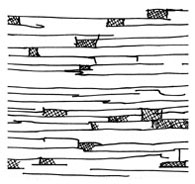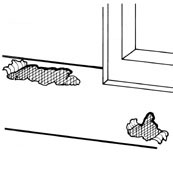Correcting Common Paint Problems: Flaking and Soft Peeling
Here are tips and suggestions on how to correct common paint problems. Homeowners all over the country experience these types of problems. Take the time to read the instructions carefully and follow them and you can correct many of the paint problems around your home.
Flaking Paint
- Paint flaking is caused by moisture that collects behind the painted surface (see image). Moisture enters the wood siding from the unpainted side. The absorbing and drying of the moisture causes repeated swelling and shrinking, thus breaking the paint film and causing it to pull away from the wood surface.
- The first step is locating the source of the moisture. Check the area for leakage from the gutters or eaves of the house. If the flaking paint is near a bathroom or kitchen, the pipes may be sweating or leaking, or excess heat may be causing condensation.
- You may need to install attic louvers, moisture vents or exhaust fans to correct the build-up of moisture.
- Scrape and sand away all flaking paint. Remove the paint as far as 12′ in all directions beyond the flaking area.
- Sand the surface down to the unpainted wood, and spot prime the area with a good grade of undercoat.
- Protect the area against moisture by caulking all seams, holes and cracks that appear in the freshly sanded area.
- After the caulking compound has thoroughly dried, apply at least one coat of a top-quality house paint according to the manufacturer’s directions. You may need to apply two coats. These steps should completely resolve the problem.
Spot Peeling
- Spot peeling sometimes occurs on the siding of a house in areas exposed to the sun’s heat (see image). Peeling is usually caused by moisture trapped in the siding that is drawn to the surface by the sun’s rays. The moisture lifts the paint away from the surface.
- The first step is locating the source of the trapped moisture. Check carefully for leaks in the gutters or eaves of the house. If the peeling area is near a kitchen or bathroom, you may need to install an exhaust fan to remove the moisture and sweat buildup.
- Louvers placed in the overhang of the root-or wedges and vents placed in the siding-sometimes allow the trapped moisture to escape.
- Remove all the old paint in the peeling area. Scrape off the paint approximately 12′ beyond the peeling area.
- Sand the surface down to the original wood and prime it with a good grade of wood undercoat.
- Caulk all holes, cracks and seams with a good grade of caulking compound to avoid a repeat of the problem.
- After the caulking compound has had time to dry thoroughly, apply at least one coat of a good grade of house paint. This should completely correct the problem.
Check your state and local codes before starting any project. Follow all safety precautions. Information in this document has been furnished by the National Retail Hardware Association (NRHA) and associated contributors. Every effort has been made to ensure accuracy and safety. Neither NRHA, any contributor nor the retailer can be held responsible for damages or injuries resulting from the use of the information in this document.
For home improvement advice, visit JS West Lumber & Ace Hardware Sonora, Ca. or visit www.acehardware.com and click on the Answers@Ace icon. Answers@Ace is an online resource with information for do-it-yourselfers about hardware and home improvement projects. The Everyday Projects section has pictures and detailed, step-by-step instructions for this and many more home improvement projects.
To speak to an Ace Hardware advisor in Sonora call: 209 532 7446.
